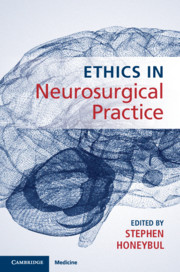Book contents
- Ethics in Neurosurgical Practice
- Ethics in Neurosurgical Practice
- Copyright page
- Contents
- Contributors
- Introduction
- Part I General Ethics
- Part II Neurosurgery-Specific Bioethics
- Part III Future Developments
- Chapter 20 Ethical Aspects of Innovation in Neurosurgery
- Chapter 21 Stem Cells and Brain Repair: Ethical Considerations
- Chapter 22 Brain-Machine Interface Technology in Neurosurgery
- Chapter 23 International Neurosurgery
- Chapter 24 Live Televised Surgery
- Index
- References
Chapter 22 - Brain-Machine Interface Technology in Neurosurgery
from Part III - Future Developments
Published online by Cambridge University Press: 29 May 2020
- Ethics in Neurosurgical Practice
- Ethics in Neurosurgical Practice
- Copyright page
- Contents
- Contributors
- Introduction
- Part I General Ethics
- Part II Neurosurgery-Specific Bioethics
- Part III Future Developments
- Chapter 20 Ethical Aspects of Innovation in Neurosurgery
- Chapter 21 Stem Cells and Brain Repair: Ethical Considerations
- Chapter 22 Brain-Machine Interface Technology in Neurosurgery
- Chapter 23 International Neurosurgery
- Chapter 24 Live Televised Surgery
- Index
- References
Summary
Diseases of the nervous system are an enormous burden to patients and society. Brain computer interfaces (BCIs) aim to improve or even eliminate the handicaps associated with these diseases by linking the brain and a computer via scalp, subdural, or intracortical electrodes. The transfer of information to and from the brain can be used to restore function. This chapter starts with a brief introduction to the recent history of BCIs, followed by the main topic of this chapter: the ethical challenges associated with BCIs. The ethical issues to be discussed include agency and identity, privacy, security, and informed consent. The management of patient and family expectations and balancing the risks and benefits of BCIs are also explored. Establishing the efficacy of BCIs and the challenges related to the principles of justice are also discussed. BCIs could potentially be used to enhance normal function, and this raises many ethical questions. In the last part of this chapter, future directions of BCIs including potential technical advances such as connectivity of the brain to ‘the cloud’ and ‘brain nets’ will be outlined. The challenges outlined in this chapter need to be addressed, both by those responsible for the technical development of BCIs, but also by neurosurgeons, policy makers, and law makers.
- Type
- Chapter
- Information
- Ethics in Neurosurgical Practice , pp. 224 - 233Publisher: Cambridge University PressPrint publication year: 2020



